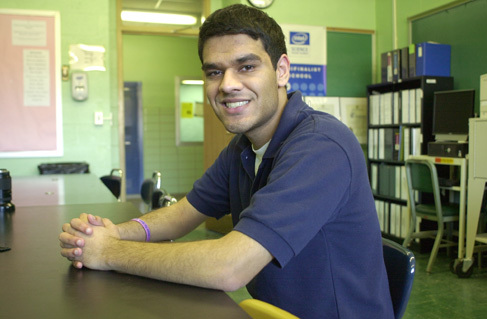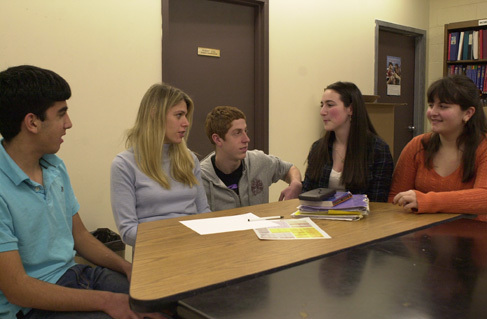Science students clean up at symposium
Ninety of Long Island's top science and mathematics students recently convened at SUNY Stony Brook's Charles B. Wang Center to compete in the prestigious Long Island Junior Science and Humanities Symposium, and in the crowd were five -- count 'em, five -- young Bellmore-Merrick Central High School District researchers, all seniors -- four from Kennedy High School and one from Calhoun.
Getting to the symposium was no easy feat. Each year nearly 300 students submit original research papers in science, engineering or mathematics to LIJSHS, which are vetted by a panel of educators. Only one-third of the papers, entered by students from 33 high schools, were accepted for presentation at the daylong symposium this year. The Army, Navy and Air Force sponsored the event, which was administered by the Academy of Applied Science.
Kennedy students Morgan Drucker, Stephanie Sager, Jeremy Roberts and Daniel Bornstein, a Herald student columnist and his class's salutatorian, had their papers accepted at the symposium. They were joined by Calhoun's Sunil Shah.
At the event, students were asked to give 12-minute PowerPoint presentations and answer questions for five minutes on their papers. They competed for a total of $5,500 in prize money split among the first-, second- and third-place winners. While none of the Bellmore-Merrick students finished in the top three, each was a winner, said Barbi Frank, a Kennedy High School research mentor.
Here's more on the students and their work:
Morgan Drucker, Kennedy
Drucker, who set up the Kids Komfort Kids charity at Schneider's Children's Hospital and played travel soccer, conducted her research on autism at the Developmental Disabilities Institute in Medford, in Suffolk County. Drucker said that children with autism often have trouble mastering an important social skill that psychologists call "joint attention," the ability to focus on an inanimate object while also following oral instructions.
Drucker explored ways to improve children's joint attention, a skill that most people give little thought to. She developed a checklist of verbal and physical cues intended to help a child focus on an object while following instructions. The child's teacher would point to the object, look at it and comment on it, while the object made a noise. Drucker, who videotaped her sessions with students, removed the cues one by one after they were repeated a number of times. She conducted her research two to three days a week over the summer of 2008. In the end, she concluded that the subjects' joint attention did not significantly improve, but because it was conducted with a limited number of children -- two -- it was impossible to say definitively whether joint attention can or cannot be improved in all cases.
Stephanie Sager, Kennedy
Sager, secretary of the Kennedy Key Club and an active volunteer with the Rosemary Kennedy BOCES School for children with developmental disabilities in Wantagh, studied the efficacy of the tumor-suppressing medication Tarceva, which is used in the treatment of lung cancer and advanced pancreatic cancer.
Tarceva, developed by OSI Pharmaceuticals, Genentech and Roche, is known as an epidermal growth factor receptor inhibitor. In essence, its purpose is to speed up the death of cancerous cells. Sager, who conducted her research at Mt. Sinai Medical Center, looked at whether Tarceva could be useful in the treatment of ovarian cancer.
Jeremy Roberts, Kennedy
Roberts, a member of Kennedy's track and cross-country squads as well as the Challenge and Science Olympiad teams, conducted a genetic engineering project at Hofstra University in the summer of 2009, looking to improve the strength of cotton fibers. Roberts tended to cotton plants, applying growth hormone to them with an eyedropper in order to improve the plants' wall thickness and reduce the number of breakage points in the cotton itself.
Daniel Bornstein, Kennedy
Bornstein, who hopes to become an international correspondent covering the poor in developing nations, examined the poplar tree as a potential biofuel to replace corn-based ethanol. If the poplar can grow on what is essentially dead soil, Bornstein reasoned, it could potentially be grown around the globe in places where no tree has traditionally survived.
Bornstein focused on whether endophytic bacteria increases the "light-use efficiency" of poplars; that is, whether it helps the trees photosynthesize, producing energy form sunlight. He conducted his research at Brookhaven National Laboratory and concluded that the bacteria has no effect on light-use efficiency.
Sunil Shah, Calhoun
Shah, a member of Calhoun's Key Club and a volunteer at North Shore-LIJ Hospital, compared virtual colonoscopies -- which produce 3D images of the colon using a CT Scan -- with invasive colonoscopies, which send a small camera through the colon to take photographs, looking for polyps and cancerous growths.
Virtual colonoscopies, if effective enough, could eliminate the need for invasive procedures, which always carry a small risk. The camera, Shah noted, can perforate the colon. But Shah's research, conducted at SUNY Stony Brook Medical Center, concluded that the virtual colonoscopy produced a greater number of false positives than did the surgical procedure.
Comments about this story? SBrinton@liherald.com or (516) 569-4000 ext. 203.









